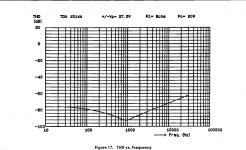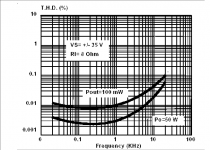Hey all,
I've noticed that some in-the-know have commented that they like the sound of amps with distortion that is relatively flat with respect to frequency. The overall level of distortion seems less important.
Most amp chips / car chips look like:

www.ti.com/lit/ds/symlink/lm3886.pdf
Which have a flatish distortion profile with regard to frequency?
I've noticed two so far: LM1875 and TDA1521
LM1875:

www.ti.com/lit/ds/symlink/lm1875.pdf
TDA1521:

View attachment TDA1521Q.pdf
Any other chips to try (could include class D, ...)?
Thanks and Cheers,
Jeff
PS Graph power is 50/30W, 10W and 6W respectively.
I've noticed that some in-the-know have commented that they like the sound of amps with distortion that is relatively flat with respect to frequency. The overall level of distortion seems less important.
Most amp chips / car chips look like:

www.ti.com/lit/ds/symlink/lm3886.pdf
Which have a flatish distortion profile with regard to frequency?
I've noticed two so far: LM1875 and TDA1521
LM1875:

www.ti.com/lit/ds/symlink/lm1875.pdf
TDA1521:

View attachment TDA1521Q.pdf
Any other chips to try (could include class D, ...)?
Thanks and Cheers,
Jeff
PS Graph power is 50/30W, 10W and 6W respectively.
Last edited:
Generally the amps with no-feedback or amplifiers with extremely high negative feedback will behave in this way.
First group of amplifiers with its high overall non-linear distortion of low-order-only products will most probably produce 'audiophile' sound character like warmth, rich timbre, openess, airyness, or something similar...
Second group will just produce totally accurate sound. Utterly clean and transparent, musical, life-like and natural.
Between them is the vast world of amplifiers (90% of all amplifiers) called by me 'I would like but I am afraid' to use the feedback. Too much to be good, to little to work well. Strange but true. These amplifiers often have too little GBW, to weak open-loop gain, hence loop gain is too low to produce consistent results across audio band. They tend to sound harsh, analytical, with 'powerful bass' - phenomenon associated with psychoacoustics. These are recognized straight by THD products rapidly rising in high frequency range.
These also can be associated with load influence on amplifier itself. Extremely high level of NF will tend to immunity from load (refer to output impedance versus frequency - rarely published!) - all dependancies between load and amplifier outputs (especially linear) are still not so well known. I bet you will be hard-pressed to find any of amplifier with published data with measured totally flat (and low!) output impedance from 20Hz till 20 kHz...
In Class-D there is the king of high feedback approach - NCore. This is their THD vs freq. response:

Worth read:
https://linearaudio.net/sites/linearaudio.net/files/volume1bp.pdf
First group of amplifiers with its high overall non-linear distortion of low-order-only products will most probably produce 'audiophile' sound character like warmth, rich timbre, openess, airyness, or something similar...
Second group will just produce totally accurate sound. Utterly clean and transparent, musical, life-like and natural.
Between them is the vast world of amplifiers (90% of all amplifiers) called by me 'I would like but I am afraid' to use the feedback. Too much to be good, to little to work well. Strange but true. These amplifiers often have too little GBW, to weak open-loop gain, hence loop gain is too low to produce consistent results across audio band. They tend to sound harsh, analytical, with 'powerful bass' - phenomenon associated with psychoacoustics. These are recognized straight by THD products rapidly rising in high frequency range.
These also can be associated with load influence on amplifier itself. Extremely high level of NF will tend to immunity from load (refer to output impedance versus frequency - rarely published!) - all dependancies between load and amplifier outputs (especially linear) are still not so well known. I bet you will be hard-pressed to find any of amplifier with published data with measured totally flat (and low!) output impedance from 20Hz till 20 kHz...
In Class-D there is the king of high feedback approach - NCore. This is their THD vs freq. response:

Worth read:
https://linearaudio.net/sites/linearaudio.net/files/volume1bp.pdf
Last edited:
I can only agree with all that Windforce said.
I want to add one thing, to the OP, when the THD is extremely low, the HF distortion is impossible to be heard as well, even if the curve is raising. Talking in general as well, not just about chipamps. Take the lm3886 which doesn't look that good on paper, but it can be made to ppm level distortion.
Last thing, 1W THD is much more important than full power one.
I want to add one thing, to the OP, when the THD is extremely low, the HF distortion is impossible to be heard as well, even if the curve is raising. Talking in general as well, not just about chipamps. Take the lm3886 which doesn't look that good on paper, but it can be made to ppm level distortion.
Last thing, 1W THD is much more important than full power one.
For reference Philips TDA1541A THD vs. Freq. measurement from appl. note.
Yup, and this is a serious problem.
- Status
- Not open for further replies.
- Home
- Amplifiers
- Chip Amps
- Amp chips with flat distortion vs frequency: LM1875, TDA1521, ...


